Abstract
Structure of complex coacervate core micelles in aqueous solution formed by oppositely charged polyelectrolytes based on poly(ethylene oxide-b-allyl glycidyl ether) (PEOAGE) diblock copolymer was investigated using dynamic light scattering (DLS) and small-angle neutron scattering (SANS). Two PEOAGE diblock copolymers are prepared by anionic ring-opening polymerization to provide PEOAGE-1 (M n,PEO = 5000 g/mol and M n,PAGE = 2700 g/mol) and PEOAGE-2 (M n,PEO = 5000 g/mol and M n,PAGE = 5500 g/mol). PAGE block in the diblock copolymer was functionalized with either primary amine or sulfonate group by thiol-ene click chemistry to generate two oppositely charged block copolyelectrolytes. In addition, unfunctionalized PAGE block is hydrophobic, and therefore PEOAGE block copolymer in aqueous solution forms hydrophobic driven micelles, which is used as control. Combination of DLS and SANS provides micelle dimension including overall micelle size, core radius, and aggregation number. Based on the results, hydrophobic driven micelles show relatively well-defined cores, and morphology changes from sphere to cylinder as PAGE block length increases. Spherical cores in complex coacervate core micelles are significantly swollen by water, and diffusive in comparison to hydrophobic driven micelles.





Similar content being viewed by others
References
Bungenberg-de-Jong H (1932) Coacervation and its meaning for biology. Protoplasma 15:110–173
Wang Q, Schlenoff J (2014) The polyelectrolyte complex/coacervate continuum. Macromolecules 47:3108–3116
Voets IK, de Keizer A, Cohen Stuart MA (2009) Complex coacervate core micelles. Adv Colloid Interface 147–148:300–318
Bohidar HB (2008) Coacervates: a novel state of soft matter: an overview. J Surf Sci Technol 24:105–124
Van der Burgh S, de Keizer A, Cohen Stuart MA (2004) Complex coacervation core micelles. Colloidal stability and aggregation mechanism. Langmuir 20:1073–1084
Hwang DS, Zeng H, Srivastava A, Krogstad DV, Tirrell M, Israelachvili JN, Waite JH (2010) Viscosity and interfacial properties in a mussel-inspired adhesive coacervate. Soft Matter 6:3232–3236
Harada A, Togawa H, Kataoka K (2001) Physicochmical properties and nuclease resistance of antisense-oligodeoxynucleotides entrapped in the core of polyion complex micelles composed of poly(ethylene glycol)-poly(l-lysine) block copolymers. Eur J Pharm Sci 13:35–42
Harada A, Kataoka K (2003) Effect of charged segment length on physicochemical properties of core-shell type polyion complex micelles from block ionomers. Macromolecules 36:4995–5001
Berret JF, Vigolo B, Eng R, Herve P (2004) Electrostatic self-assembly of oppositely charged copolymers and surfactants: a light, neutron, and X-ray scattering study. Macromolecules 37:4922–4930
Berret JF, Schonbeck N, Gazeau F, Kharrat DE, Snadre O, Vacher A, Airiau M (2006) Controlled clustering of superparamagnetic nanoparticles using block copolymers: design of new contrast agents for magnetic resonance imaging. J Am Chem Soc 128:1755–1761
Voets IK, Van Der Burgh S, Farago B, Fokkink R, Kovacevic D, Hellweg T, De Keizer A, Cohen Stuart MA (2007) Electrostatically driven coassembly of a diblock copolymer and an oppositely charged homopolymer in aqueous solutions. Macromolecules 40:8476–8782
Hunt JN, Feldman KE, Lynd NA, Deek J, Campos LM, Spruell JM, Hernandez BM, Kramer EJ, Hawker CJ (2011) Tunable, high modulus hydrogels driven by ionic coacervation. Adv Mater 23:2327–2331
Uygun M, Tasdelen MA, Yagci Y (2010) Influence of type of initiation on thiol-ene “click” Chemistry. Macromol Chem Phys 211:103–110
Hrubý M, Koňák Č, Ulbrich K (2005) Poly(allyl glycidyl ether)-block-poly(ethylene oxide): a novel promising polymeric intermediate for the preparation of micellar drug delivery systems. J Appl Polym Sci 95:201–211
Lee BF, Kade MJ, Chute JA, Gupta N, Campos LM, Fredrickson GH, Kramer EJ, Lynd NA, Hawker CJ (2011) Poly(allyl glycidyl ether)-A versatile and functional polyether platform. J Polym Sci A Polym Chem 49:4498–4504
Ortony JH, Choi S, Spruell JM, Hunt JN, Lynd NA, Krogstad DV, Urban VS, Hawker CJ, Kramer EJ, Han S (2014) Fluidity and water in nanoscale domains define coacervate hydrogels. Chem Sci 5:58–67
Krogstad DV, Choi S, Lynd NA, Audus DJ, Perry SL, Gopez JD, Hawker CJ, Kramer EJ, Tirrell MV (2014) Small angle neutron scattering study of complex coacervate micelles and hydrogels formed from ionic diblock and triblock copolymers. J Phys Chem B 118:13011–13018
Bang J, Jain S, Li Z, Lodge TP (2006) Sphere, cylinder, and vesicle nanoaggregates in poly(styrene-b-isoprene) diblock copolymer solutions. Macromolecules 39:1199–1208
Hanley KJ, Lodge TP (2000) Phase behavior of a block copolymer in solvents of varying selectivity. Macromolecules 33:5918–5931
Acknowledgments
This research was supported by the National Research Foundation of Korea (NRF) Grant Funded by the Korean Government (MSIP) (Nos. NRF-2013R1A1A1007861 and NRF-2013 M2B2A4041278), and by 2014 Hongik University Research Fund.
Author information
Authors and Affiliations
Corresponding author
Electronic supplementary material
Below is the link to the electronic supplementary material.
289_2016_1669_MOESM1_ESM.docx
Procedure for synthesis, NMR (Nuclear Magnetic Resonance) and SEC (Size Exclusion Chromatography) of PEOAGE-1 and 2 are available. Also, detailed SANS fitting model is available. (DOCX 1687 kb)
Rights and permissions
About this article
Cite this article
Lim, P., Shin, H., Moon, B. et al. Small angle neutron scattering study on complex coacervate core micelles formed by oppositely charged poly(ethylene oxide-b-allyl glycidyl ether) block copolymer in water. Polym. Bull. 73, 2417–2425 (2016). https://doi.org/10.1007/s00289-016-1669-4
Received:
Revised:
Accepted:
Published:
Issue Date:
DOI: https://doi.org/10.1007/s00289-016-1669-4




